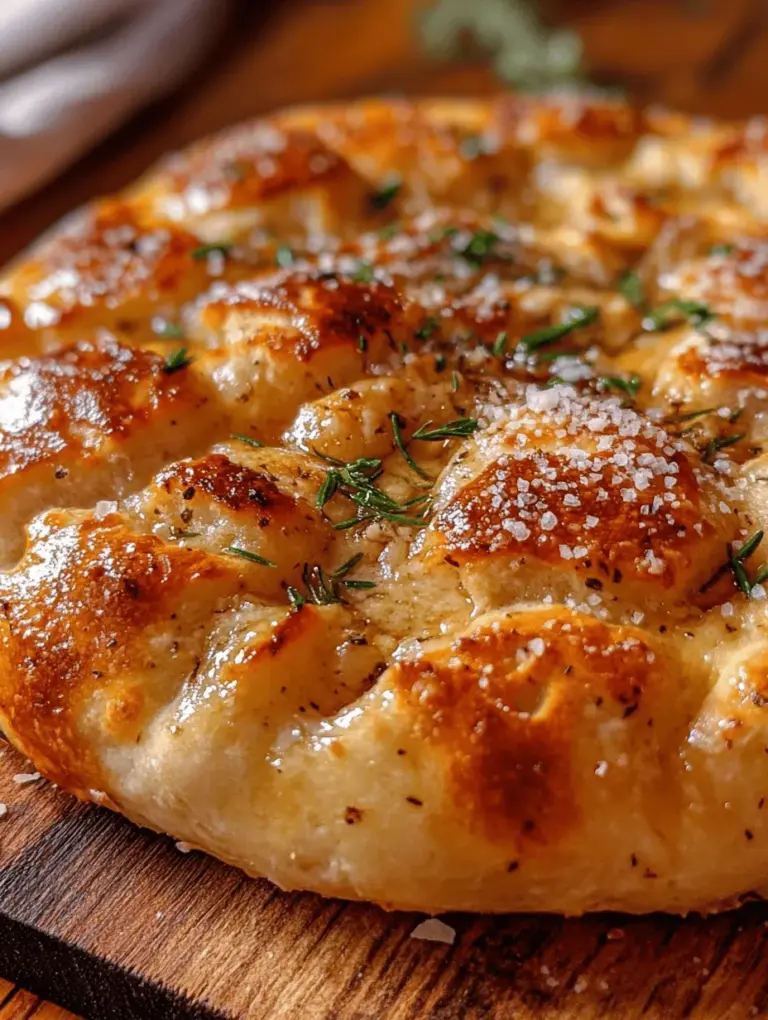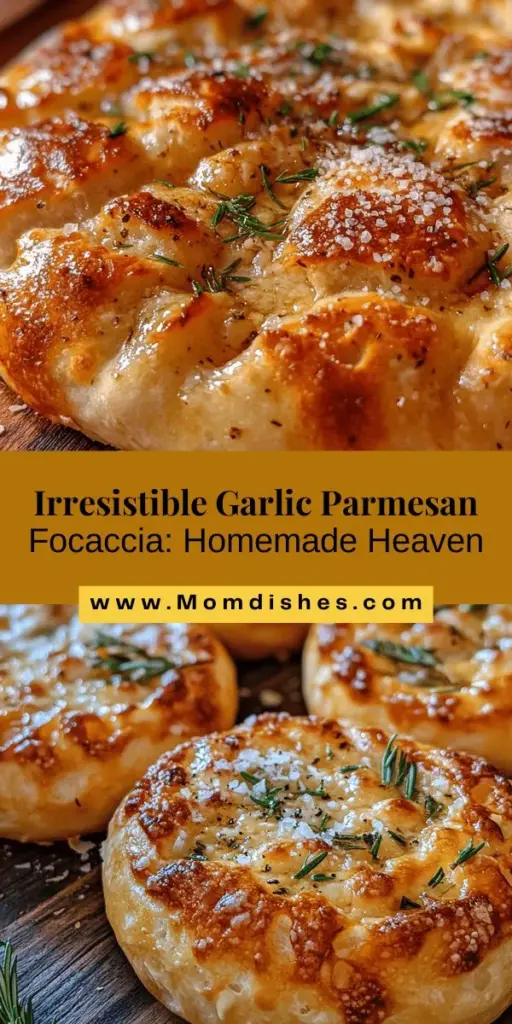Homemade bread has a way of transforming a simple meal into a memorable experience, and few recipes capture this magic quite like Garlic Parmesan Focaccia Bread. This Italian classic is not just any bread; it is a celebration of flavors and textures that elevates the dining experience. With its crisp, golden crust and soft, pillowy interior, Garlic Parmesan Focaccia is infused with the fragrant aroma of garlic, the rich umami of aged Parmesan cheese, and the earthy notes of fresh rosemary. Whether served as an appetizer, a side dish, or the base for a gourmet sandwich, this focaccia is versatile enough to fit any occasion.
Focaccia’s charm lies in its simplicity and adaptability. The addition of garlic and Parmesan elevates this traditional Italian flatbread, creating a savory treat that is perfect for sharing. The blend of ingredients allows for endless customization; you can experiment with additional toppings such as olives, sundried tomatoes, or even a drizzle of balsamic glaze. In this article, we’ll delve into the captivating world of Garlic Parmesan Focaccia Bread, exploring its history, the essential ingredients, and guiding you through the initial steps of creating this delightful dish.
Understanding Focaccia: A Brief History and Its Variations
Focaccia has a rich history that dates back to ancient Roman times, where it was referred to as “panis focacius,” meaning “hearth bread.” Originally, focaccia was baked on hot stones or in the ashes of the hearth, making it a staple among the early Romans. As time progressed, the recipe spread throughout Italy, each region adding its own twists and variations based on local ingredients and culinary traditions.
In Liguria, for example, the focaccia is known for its olive oil-rich texture and often features toppings like olives and herbs. Meanwhile, in Puglia, it may be adorned with cherry tomatoes and sea salt. The beauty of focaccia lies in its versatility; it can be made with various flours, toppings, and flavors, making it an ever-evolving dish that appeals to many palates.
The addition of garlic and Parmesan to focaccia is a relatively modern twist that showcases the harmonious blend of flavors. Garlic, with its aromatic qualities, pairs beautifully with the nutty richness of Parmesan cheese, while a sprinkle of fresh rosemary adds an aromatic finish. Together, these ingredients create a focaccia that is not only delicious but also a visual delight, inviting you to take a bite.
Ingredients Breakdown: What You Need for Garlic Parmesan Focaccia
To make Garlic Parmesan Focaccia Bread, you’ll need a few essential ingredients that work together to create the perfect loaf. Each component plays a pivotal role in achieving the desired flavor and texture. Here’s a breakdown of what you’ll need:
1. All-Purpose Flour
All-purpose flour is the backbone of any bread recipe. It provides the necessary structure and chewiness that makes focaccia satisfying to eat. The protein content in all-purpose flour helps develop gluten, which contributes to the bread’s airy texture. While you can experiment with other flours, all-purpose flour is the most versatile choice for this recipe.
2. Instant Yeast
Using instant yeast is advantageous for beginners and seasoned bakers alike. Unlike active dry yeast, which requires proofing in warm water, instant yeast can be mixed directly into the dry ingredients. This results in a more straightforward process without the waiting period, allowing your dough to rise faster and more consistently.
3. Sugar
Sugar may seem like an optional ingredient, but it plays a crucial role in bread-making. Not only does sugar enhance the flavor by adding a hint of sweetness, but it also aids in browning the crust during baking. Additionally, sugar serves as food for the yeast, promoting a more robust rise in the dough.
4. Salt
Salt is essential in any bread recipe, as it enhances flavor and regulates yeast activity. A pinch of salt can make a significant difference in the overall taste of the focaccia. It balances the sweetness of the sugar and prevents the yeast from over-fermenting, ensuring a well-risen and flavorful bread.
5. Warm Water
The temperature of the water is critical when activating yeast. Warm water (around 110°F or 43°C) provides the ideal environment for yeast to thrive. Too hot, and you risk killing the yeast; too cold, and it may not activate effectively. Using warm water sets the stage for a successful rise in your focaccia.
6. Olive Oil
Olive oil is a star ingredient in focaccia, adding both flavor and moisture. It creates a tender crumb and a crispy exterior, making each bite delightful. Additionally, a generous drizzle of olive oil on top before baking enhances the bread’s richness and contributes to its golden color.
7. Garlic
Garlic is the heart and soul of this Garlic Parmesan Focaccia. It imparts a robust aroma and a savory flavor that complements the cheese beautifully. Whether you choose to use fresh garlic cloves or roasted garlic, this ingredient is key to achieving that signature taste.
8. Parmesan Cheese
Parmesan cheese brings depth and complexity to the focaccia. Its nutty, salty flavor enhances every bite, making it irresistible. For the best results, use freshly grated Parmesan, as pre-packaged varieties may lack the same flavor and texture.
9. Rosemary (Optional)
Fresh rosemary can elevate the taste and aroma of your focaccia. Its earthy, pine-like flavor pairs harmoniously with garlic and Parmesan. While optional, adding rosemary enhances the overall sensory experience of the bread.
10. Coarse Sea Salt
Finally, a sprinkle of coarse sea salt as a finishing touch will add bursts of flavor and a pleasing texture to the crust. It provides a delightful contrast to the soft interior of the focaccia, making each bite a delightful experience.
Step-by-Step Instructions for Making Garlic Parmesan Focaccia
Now that you understand the ingredients and their roles, it’s time to dive into the process of making Garlic Parmesan Focaccia Bread. Follow these detailed instructions to ensure your focaccia turns out perfectly.
Mixing the Dough
Start by gathering all your ingredients and a large mixing bowl. In the bowl, combine the all-purpose flour, instant yeast, sugar, and salt. Mix these dry ingredients until they are evenly distributed. Creating a well in the center, pour in the warm water and a generous amount of olive oil. Using a wooden spoon or your hands, begin to mix the dough until it comes together.
Once the mixture forms a shaggy dough, transfer it to a lightly floured surface. Knead the dough for about 5-7 minutes, until it is smooth and elastic. If the dough feels too sticky, sprinkle a little more flour as needed. This step is crucial for developing gluten, which will give your focaccia its characteristic texture.
First Rise
After kneading, shape the dough into a ball and place it in a lightly greased bowl. Cover the bowl with a clean kitchen towel or plastic wrap to protect it from drafts. Allow the dough to rise in a warm, draft-free area for about 1 to 1.5 hours, or until it has doubled in size. The rising process is vital, as it allows the yeast to ferment and produce carbon dioxide, which creates the light and airy structure of the focaccia.
While the dough rises, you can prepare your garlic and Parmesan topping. Finely mince the garlic and set it aside. Grate the Parmesan cheese if you haven’t already, ensuring it is ready to sprinkle over the dough once it’s risen.
As you wait, the aroma of the rising dough will fill your kitchen, creating an atmosphere of anticipation for the delicious focaccia that is about to be baked.
Stay tuned for the next steps, where we will guide you through shaping the dough, adding toppings, and baking your Garlic Parmesan Focaccia to golden perfection.
{{image_1}}
Shaping the Focaccia
Once your dough has risen and doubled in size, it’s time to shape it into a delightful focaccia. Start by generously greasing your baking pan with olive oil to ensure that the bread doesn’t stick and develops a beautifully crisp crust. If you prefer a more rustic appearance, an aluminum or cast-iron pan works well; however, a baking sheet lined with parchment paper is also a great alternative.
Gently punch down the dough to release any trapped air bubbles. Transfer the dough to your oiled pan by using a bench scraper or your hands. If the dough feels sticky, lightly flour your hands to prevent it from clinging. Once transferred, use your fingers to gently stretch and press the dough into the corners of the pan. Don’t worry if it doesn’t fit perfectly; focus on evenly distributing the thickness throughout. With its naturally soft and pliable nature, the dough will relax and fill the pan as it rises again.
To create that iconic focaccia look, use your fingers to dimple the surface of the dough. Press down firmly but not too hard, creating deep wells that will hold the garlic and oil mixture. This step not only adds visual appeal but also helps to trap the toppings, ensuring that each bite is packed with flavor.
Preparing the Topping
The topping is where the magic of Garlic Parmesan Focaccia truly begins. In a small saucepan, combine a generous amount of olive oil with minced garlic over medium heat. Allow the garlic to infuse the oil without browning – this should take about 3 to 5 minutes. The goal is to create a fragrant, golden oil that will enhance the flavor of the focaccia.
Once the oil has cooled slightly, drizzle it generously over the dimpled dough, ensuring that each well captures a bit of that aromatic goodness. For an extra kick, consider adding a pinch of red pepper flakes or a sprinkle of sea salt for added texture.
Next, sprinkle freshly grated Parmesan cheese evenly over the surface, allowing it to melt and create a delightful crust as it bakes. If you want to elevate the flavor profile further, consider adding fresh herbs like rosemary or thyme. Simply chop them finely and scatter them over the dough before baking. This not only adds flavor but also provides a beautiful pop of color.
Second Rise
After applying the toppings, let your shaped focaccia undergo a second rise. Cover the pan with a clean kitchen towel or plastic wrap to keep the dough warm and moist. This step typically takes about 30 to 45 minutes, depending on your kitchen temperature. The second rise is crucial as it contributes to the airy texture of the focaccia, giving it that light, fluffy crumb we all love.
During this time, preheat your oven to 425°F (220°C) so that it’s ready to bake as soon as the dough is finished rising. You’ll know it’s ready when the dough has puffed up nicely and feels airy to the touch.
Baking
Baking the focaccia is where all your hard work pays off. Carefully place the pan into the preheated oven and set a timer for about 20 to 25 minutes. Keep an eye on it as baking times can vary depending on your oven and the thickness of the focaccia.
To know when your focaccia is properly baked, look for a golden-brown crust that is crisp to the touch. If you gently tap the bottom of the focaccia, it should sound hollow. For an even more decadent finish, you can brush the top with a little extra olive oil and sprinkle a bit more Parmesan cheese halfway through the baking time. This will create a beautiful, rich crust that is irresistible.
Tips for Perfecting Your Focaccia
Adjusting Dough Consistency
Focaccia dough can be a bit sticky, especially if you’re new to bread-making. If your dough seems too wet, gradually sprinkle in a little extra flour while kneading until it reaches a soft, pliable consistency. Conversely, if it feels too dry, a splash of water can help achieve the desired texture. Remember, the goal is a dough that is slightly tacky but not overly sticky.
Flavor Variations
While garlic and Parmesan are classic toppings, don’t be afraid to get creative! Consider adding sun-dried tomatoes, olives, or roasted red peppers for a Mediterranean twist. Fresh herbs like basil or oregano can also enhance the flavor profile. For a bit of sweetness, try drizzling a honey glaze over the finished focaccia or incorporating caramelized onions into the dough before baking.
Storage Recommendations
If you have any leftover focaccia (which is rare, but can happen), store it in an airtight container at room temperature for up to 2 days. For longer storage, wrap it tightly in plastic wrap and freeze it for up to a month. To reheat, simply place the frozen focaccia in a preheated oven at 350°F (175°C) for about 10-15 minutes, or until warmed through. This will help restore its original texture and flavor.
Serving Suggestions: How to Enjoy Garlic Parmesan Focaccia
Pairing with Dips
Garlic Parmesan Focaccia is incredibly versatile and pairs beautifully with a variety of dips. Consider serving it alongside a simple balsamic vinegar and olive oil mixture for dipping. A sprinkle of fresh herbs or a dash of cracked black pepper can elevate this pairing even further. Alternatively, hummus or tzatziki offers a refreshing contrast to the rich flavors of the focaccia.
Using as a Sandwich Base
One of the best ways to enjoy focaccia is by using it as a sandwich base. Its hearty and flavorful structure makes it perfect for holding up to robust fillings. Layer deli meats, fresh veggies, and your favorite condiments between two slices of focaccia for a satisfying sandwich that’s perfect for lunch or a picnic.
Accompanying Main Dishes
Garlic Parmesan Focaccia also shines as a side dish. Serve it alongside soups, salads, or grilled meats to complement your meal. Its delightful texture and flavor make it an ideal accompaniment to hearty dishes like minestrone soup or a vibrant arugula salad.
Nutritional Information: A Closer Look at Garlic Parmesan Focaccia
Caloric Content
While homemade focaccia is undoubtedly a treat, it’s wise to be aware of its caloric content. On average, a serving of Garlic Parmesan Focaccia (approximately 1/8 of a 9×13-inch pan) contains about 200-250 calories. This can vary based on the amount of oil and cheese used, so be mindful of portion sizes if you’re watching your intake.
Health Benefits
This focaccia is not only delicious but also boasts several health benefits thanks to its key ingredients. Olive oil, a main component, is rich in monounsaturated fats and antioxidants, which can promote heart health. Garlic is known for its immune-boosting properties, while the herbs contribute additional vitamins and minerals.
Dietary Considerations
For those with dietary restrictions, there are ways to enjoy Garlic Parmesan Focaccia. Gluten-free alternatives are widely available, including gluten-free all-purpose flour blends. However, be sure to follow specific instructions as gluten-free flours can behave differently than traditional wheat flour.
Conclusion: Enjoying the Fruits of Your Labor
There’s a profound sense of accomplishment that comes from making homemade Garlic Parmesan Focaccia. The process of mixing and kneading the dough, allowing it to rise, and finally watching it bake to golden perfection fills your kitchen with an aroma that is simply irresistible.
As you slice into the warm, fluffy focaccia, take a moment to appreciate the effort you put into creating this delicious bread. Whether enjoyed on its own, used as a sandwich base, or served alongside your favorite dishes, Garlic Parmesan Focaccia is sure to impress family and friends alike.
We encourage you to share your experiences, variations, and any creative twists you add to the recipe. Baking bread from scratch is not just about the end product; it’s about the joy of cooking, the love that goes into each step, and the memories created around the table. Enjoy every bite, and let the warmth of homemade bread bring you closer to your loved ones.


